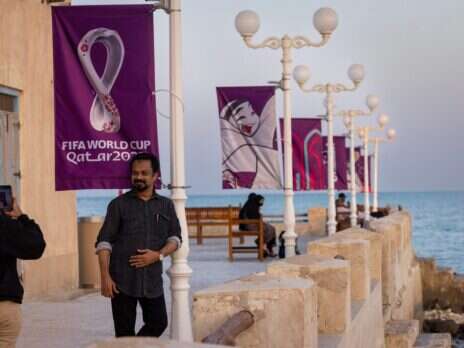One of Moore’s best pictures was of Saddam’s statue being pulled down
Daily Mirror photographer Mike Moore flew back from Amman on Wednesday after two months in Baghdad learning the crucial lesson of this Iraq war – that journalists were as likely to be killed by “friendly fire” as by the enemy.
Moore, 49, has covered so many wars he has given up counting. “What this war has taught us is that you can expect fire from your own people as well as from the enemy, which was proved when the Palestine Hotel was hit by the American tank. That was a dreadful thing,” he said. After watching tank guns trained on the hotel for two hours, he had then gone out on to the streets. “When I got back to the hotel, I found that the Reuters journalist had been killed.”
Targeted himself on several occasions, Moore said: “If you hear gunfire, it’s difficult to know whether it’s actually aimed at you or over your head. I was always more worried about being shot at by the Americans than I was by the Iraqis.”
Moore covered his first war in 1979 when the Russians were fighting in Afghanistan. He stopped counting after his ninth. But the Iraq conflict is the first from which his wife believed he might not return.
When he spoke to her from Amman, she confessed this had been the war that worried her most, mainly because of the training courses he had been on during the build-up. He had learned how to inject himself against chemical warfare, how to wear a gas mask, and how to survive bullet wounds. “It’s all part of the job to us, but you tend to forget the impact it has on your family. It suddenly brought it home to me.”
But, as a photographer, what also stood out for him from this war was that “from a visual point of view, it has been the most photogenic.
“We had a grandstand seat from the 16th floor of the Palestine Hotel. We were able to watch this surreal blitz happening in front of us, especially the night of the shock and awe bombing [Friday, 21 March]. I don’t think people have seen the like of this for decades and to have cameras rolling from just a few hundred yards across the river as the centre was bombed was a unique experience. To see the precision of it was particularly shocking and to go out the next day and see the still smouldering remains made you realise the power that we could unleash.”
The downside came when the journalists were taken out to see the “massive” civilian casualties.
For him, the best pictures came in phases – pre-war, young suicide bombers wrapped in white to symbolise shrouds; then the night of the heavy bombing; next, the Americans arriving and being given flowers; and, finally, the symbolic end when the statue of Saddam was pulled down.
Moore has seen none of the other newspapers’ coverage of the war. He had access to the Mirror website only on his laptop. There was no television. “One of the biggest problems was that we were in this media war where everyone was saturated with 24-hour coverage and rolling news and the people there were so cut off,” he said.
By Jean Morgan
Email pged@pressgazette.co.uk to point out mistakes, provide story tips or send in a letter for publication on our "Letters Page" blog





